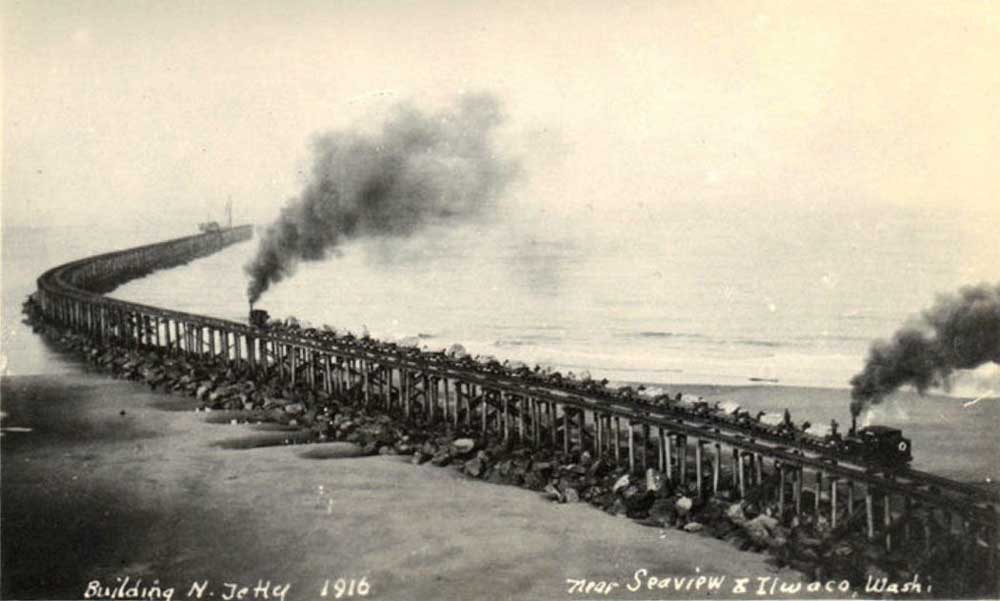Major work to begin on jetties this fall $257 million project will impact Ilwaco and Cape D park for years
Published 9:46 am Friday, September 26, 2014

- A custom-built rail system delivered giant rocks to construct North Jetty. A documentary aims to rediscover the massive work that went into creating the jetty system at the mouth of the Columbia River.
ILWACO — Work starting on the North Jetty next month could restrict access to a popular portion of Cape Disappointment State Park year-round for the next two years while work on the entire jetty system at the mouth of the Columbia River is expected to continue well into 2021.
“What we’re telling people is don’t plan on going out on the North Jetty,” said Michelle Helms, spokesperson for the U.S. Army Corps of Engineers, which maintains the jetty system at the mouth of the Columbia River.
The Corps awarded a $5.3 million contract to Catworks Construction this week to fill in a lagoon that has formed on the inland side of North Jetty and begin stabilizing the 97-year-old structure’s foundation. Future work will mean bringing in 40,000 tons of rock through Ilwaco and into the park on flatbed trucks as early as next year, closing the west side of the parking lot for Waikiki Beach and closing parts of Jetty Road to replace a culvert. Benson Beach will likely not be accessible from Jetty Road at times and visitors will probably experience construction-related traffic. The estimated cost is $80 million.
This sort of work is easier to accommodate at some parks than at others.
Fort Stevens State Park in Oregon is just as popular during the summer months as Cape Disappointment; both parks absorb thousands of visitors every year. Fort Stevens is sprawling and boasts large campgrounds, historical areas and beach access, too. It has also hosted the Corps most recently. Contractors came in the early 2000s and last year to do major repair work on the older 6-mile-long South Jetty.
The work the Corps is planning at North Jetty will continue over several summers, and, between the two parks, Mike Stein, state park district manager for Oregon’s north coast, thinks closures at Cape Disappointment will be more challenging to manage even though the North Jetty is much shorter at 2.5 miles long.
“I think probably over here [in Oregon] we’ve got a lot more passive recreation,” he said. “It’s a lot easier for us to administrate on this side because of the physical layout of the facility.”
At Fort Stevens, visitors must travel deep into the park if they want to access the jetty. The obvious way is to drive down a long, winding road, past two other large parking lots that each have beach access. Otherwise, it’s a long hike or drive down the beach itself or a long bike ride from the campgrounds.
At Cape Disappointment, it’s a different story. North Jetty, completed in 1917, is right down the road from the entrance to the park. Visitors actually have to scramble over a portion of the jetty if they access Waikiki Beach from a particular parking lot.
Of the two main jetties, North Jetty offers a more comfortable setting nearby: sheltered Waikiki beach has driftwood perfect for building forts and waves that are often ideal for swimming and surfing. The beach on the south side of South Jetty tends to be wide and windswept. It has its own beauty and is good for walking and clamming but not so good for sunbathing and picnicking or staying warm in general.
The Corps has yet to award a contract for the work on the North Jetty, but hopes to begin in late October or early November.
The rehabilitation work is expected to continue through 2016. Work on Washington’s Jetty A is set to begin in 2015 with a more complete rehabilitation on North Jetty running from approximately 2016 to 2019. South Jetty in Fort Stevens State Park is also slated for further rehabilitation beginning in 2017.
The jetty system at the mouth of the river was intended to allow vessels predictable access to navigation channels and to improve navigation overall. Despite ongoing repair work, all three of the jetties are “currently in an unacceptable deteriorated condition,” according to a 2011 external peer review of the system. The Corps estimates it will cost $257 million to rehabilitate the three jetties.
“We’re expecting that this will be an extended closure,” said Virginia Painter, spokesperson for the Washington State Parks Commission, about the work at Cape Disappointment.
But, Stein said, at Fort Stevens, “the Corps has not been an unreasonable partner.” Besides, he added, the Corps is a landowner at the park, laying claim to various pieces of the Fort Stevens facility. If the Corps wants to come in and haul stone out to the jetty, the park’s job is to accommodate that, fencing off half of parking lot C where park visitors can access the jetty and not allowing people onto the jetty.
“We lost a lot of fishing for some folks, places they’d come to for years,” Stein said.
Still, the jetties were never intended to be places for humans to play, walk and climb, Painter and Helms say. Elsewhere in the region, people walking along jetties have become stranded due to high waves and strong winds. In some cases, they have been swept away into the ocean. The park certainly doesn’t encourage people to clamber around on the North Jetty, though people find there way over the rocks anyway and both the North and South jetties are popular fishing spots in the summer.
Once work begins, North Jetty will be completely off limits. The Corps and its contractors are responsible for securing the work area and putting up signs and fences. Despite this, park rangers will probably still spend some time educating visitors as they go about their daily tasks, Painter said.
That’s what happened at Fort Stevens State Park too. Though the Corps and its contractors handled most of the site security, park rangers also ran interference.
“There were only a couple of instances where people refused to listen to what, I think, was for their own good,” Stein said. When that happened, the park called in its contracted law enforcement.









